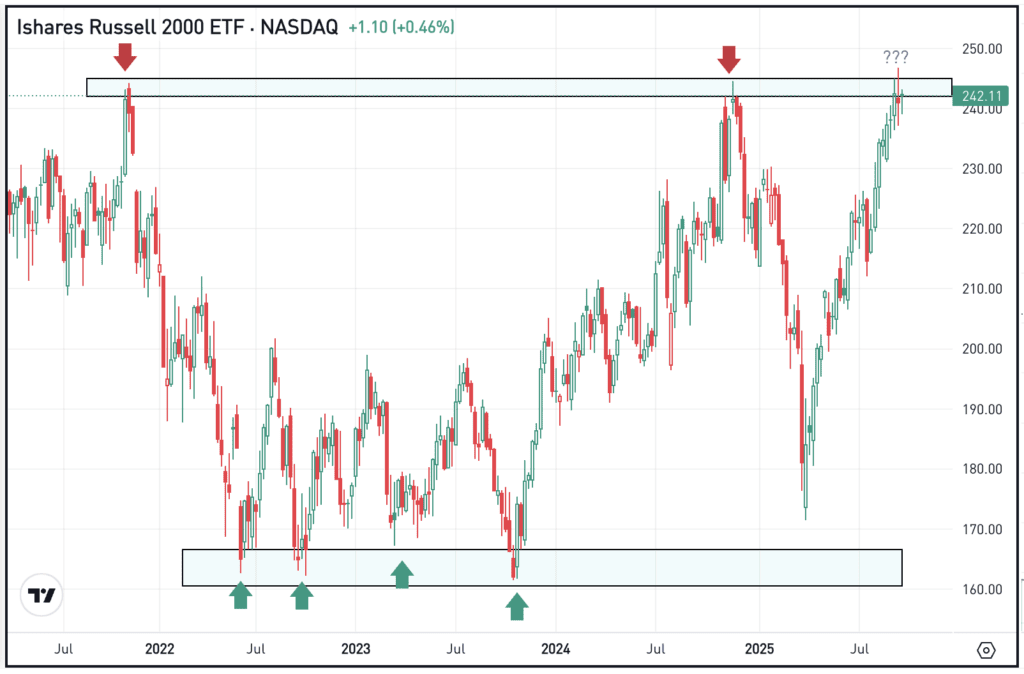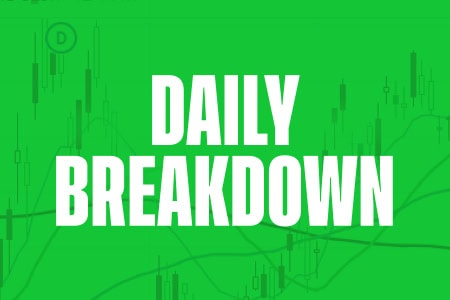Small caps recently made a run at record highs. Now The Daily Breakdown explores whether this group can maintain momentum in Q4.
Before we dive in, let’s make sure you’re set to receive The Daily Breakdown each morning. To keep getting our daily insights, all you need to do is log in to your eToro account.
What’s Happening?
Small caps have quietly been on a tear over the last few quarters. In Q2 and Q3, the Russell 2000 — tradable via the IWM ETF — has soared 21% and has rallied more than 40% from the April lows. Both metrics outpace the returns we’ve seen in the S&P 500, which stand at 19% and ~39%, respectively.
But we’ve seen this show before, where small caps perform well, only to fizzle out and lose steam. That rhetoric is extremely true so far in this bull market, as the Russell 2000 is trading at roughly the same level it was in November 2021 — the peak of the prior bull market.
Is This Time Different?
The Fed cut rates last month and is on pace to do so two more times this year, according to their most recent economic outlook. Lower rates tend to be good for businesses, and that’s particularly true for small caps — which are companies valued between $300 million and $2 billion — as they tend to be more sensitive to interest rate changes.
As we look at the next 12 to 18 months, analysts are pretty optimistic when it comes to margin expansion and cash flow growth. They also believe profit growth will be strong too, with estimates calling for 23% earnings growth over the next 12 months (vs. ~8.5% for the S&P 500).
As my colleague Lale Akoner recently wrote:
“For the first time in years, more than half of small-cap companies are seeing upward earnings revisions. This might not sound exciting, but historically this measure has spent most of its time below 50% since the late 1990s. Sustained revisions above that threshold have usually meant strong forward performance.”
The Risks
We’ll keep this portion short and sweet. Small caps have lagged its large cap peers and that could continue moving forward. If the economy slows down or the Fed doesn’t deliver on rate cuts, this group could further struggle. So while some catalysts could be lining up for Q4 and beyond, it’s not as if small caps don’t have any hurdles.
Want to receive these insights straight to your inbox?
The Setup — IWM ETF

The IWM ETF topped out near $240 to $245 in November 2021, then again in November 2024. While it technically made a new record high last week, the IWM is still contending with this area. If it’s able to break out and can begin to find this resistance level as support, then bulls might see more longer-term momentum. However, if this area again remains resistance, investors will have to stay on guard for a potential dip.
Options
As of October 2nd, the options with the highest open interest for IWM stock — meaning the contracts with the largest open positions in the options market — were the October $230 puts and the December $200 puts.
Investors who believe shares will move higher over time may consider participating with calls or call spreads. If speculating on a long-term rise, investors might consider using adequate time until expiration.
For investors who would rather speculate on the stock decline or wish to hedge a long position, they could use puts or put spreads.
To learn more about options, consider visiting the eToro Academy.
Disclaimer:
Please note that due to market volatility, some of the prices may have already been reached and scenarios played out.






